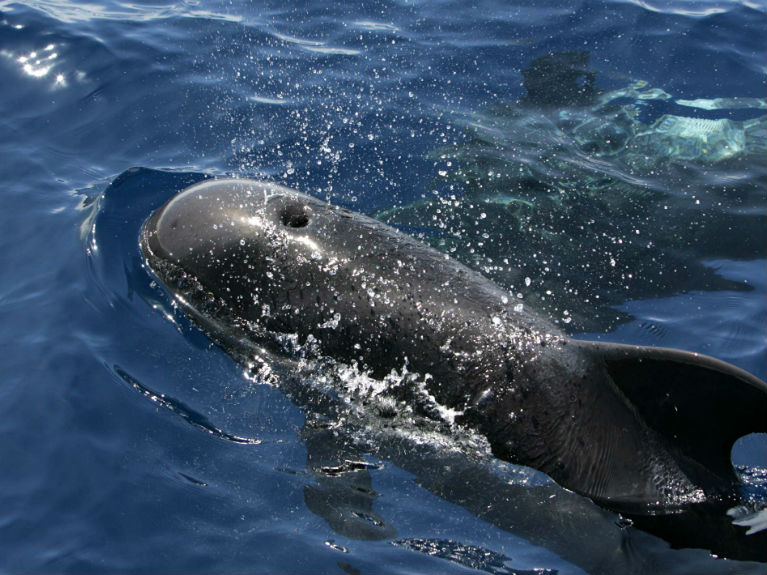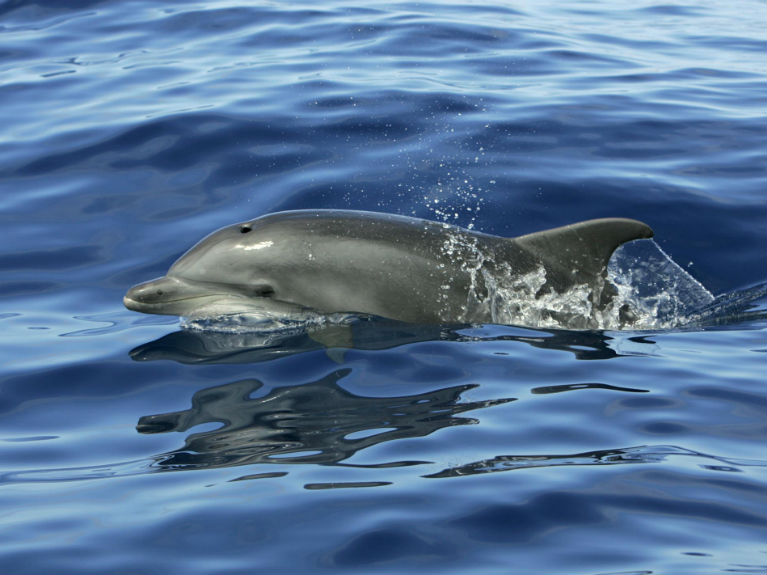Jumping through the waves, appearing above water, playing in the foam, enjoying their freedom – that’s what you’ll see the dolphins and whales of La Gomeradoing.
Watch free whales and dolphins in a sustainable excursion
The clear waters, mild temperature, and abundance of food have made La Gomera the place that these marine mammals have chosen as their regular home, which means you can watch them almost every single day of the year.
You can see more than 20 species of cetaceans in its waters, almost one-third of the species existing in the entire world!
The joy of the dolphins around the ship spreads to those who watch them; they come close and are not afraid because our way of watching them is very respectful. The companies that provide these excursions in La Gomera have been awarded the “blue flag”, a license that distinguishes them because they comply with the currently valid regulations for the respectful watching of cetaceans. On almost 100% of these trips, you can observe members of various species.
But… what exactly are cetaceans?
They are marine mammals, which is why they are not considered fish; they have to breathe above the water, although some species may hold their breath for up to 1 hour while they search for food at very high depth. They are divided into those that have teeth (odontocetes or toothed whales) and those that have baleen (mysticetes or baleen whales), but the division between dolphins and whales is better known.


They have a sophisticated system to interpret their surroundings through sound, sonar. It is very similar to the system in bats: they project a wave of sound (vibrations or clicks) that impact other objects (rocks, fish, or ships) and their ricochet (echo) is interpreted by the animal in order to realize the size, distance, etc.
Toothed whales have a varied diet, including, among other things, fish, shrimp, octopus, and squid, while baleen whales feed themselves by filtering large amounts of water through their mouth, retaining small animals, especially small crustaceans (krill).
How can we see them?
There is a wide range of companies that provide this activity. Most of the excursions start out from the port of Vueltas (Valle Gran Rey).
La Gomera, since it is the home of various species of non-migratory cetaceans, allows you to watch them almost all year round. Normally, ships do not need to travel far from the coast to ensure a successful sighting. Species such as the spotted dolphin, bottle-nose dolphin, striped dolphin, rough-toothed dolphin, fin whale, sperm whale, or pilot whale.


Some advice
To fully enjoy this experience, equip yourself suitably: wear comfortable clothing and a swimsuit if you intend to enjoy the sea, binoculars if you do not tend to get seasick, a cap, sunglasses, and sunscreen. Taking a pill to prevent seasickness is also recommended in order to enjoy the activity without any discomfort. Some companies offer food on board, which is included in the price.
To take some good pictures, ideally you should wait for the ship to stop or reduce its speed, line up to the horizon, watch the position of the sun, and if your camera has this option, choose “sports scenes”, which will allow you to take clear pictures during movement.
Are there any rules?
For a responsible sighting trip, companies are required to comply with the respective regulations. You should also know that visitors also have to follow certain rules:
The following are forbidden:
– Swimming with the animals.
– Feeding them
– Touching them
– Throwing rubbish in the water
– Bothering them by making noise
Nature, the sea, the sun, and the freedom of the dolphins and whales combine to form an unforgettable experience that will become one of the best memories of your trip to La Gomera.












